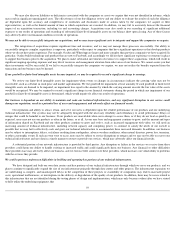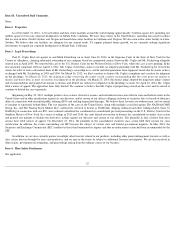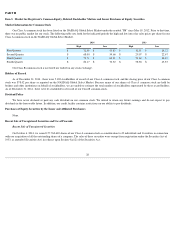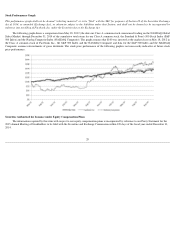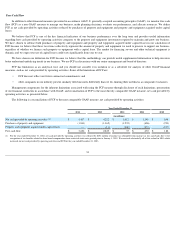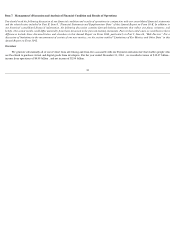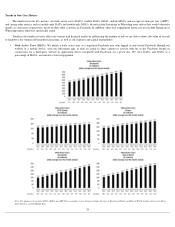Facebook 2014 Annual Report Download - page 28
Download and view the complete annual report
Please find page 28 of the 2014 Facebook annual report below. You can navigate through the pages in the report by either clicking on the pages listed below, or by using the keyword search tool below to find specific information within the annual report.
developers and competitors;
In addition, the stock markets have experienced extreme price and volume fluctuations that have affected and continue to affect the market prices
of equity securities of many technology companies. Stock prices of many technology companies have fluctuated in a manner unrelated or
disproportionate to the operating performance of those companies. We are currently subject to securities litigation in connection with our IPO. We may
experience more such litigation following future periods of volatility. Any securities litigation could subject us to substantial costs, divert resources and
the attention of management from our business, and adversely affect our business.
We do not intend to pay dividends for the foreseeable future.
We have never declared or paid cash dividends on our capital stock. We currently intend to retain any future earnings to finance the operation and
expansion of our business, and we do not expect to declare or pay any dividends in the foreseeable future. As a result, you may only receive a return on
your investment in our Class A common stock if the trading price of our Class A common stock increases. In addition, our credit facility contains
restrictions on our ability to pay dividends.
The dual class structure of our common stock and the voting agreements among certain stockholders have the effect of concentrating voting control
with our CEO and certain other holders of our Class B common stock; this will limit or preclude your ability to influence corporate matters.
Our Class B common stock has ten votes per share, and our Class A common stock has one vote per share. Stockholders who hold shares of
Class B common stock, including certain of our executive officers, employees, and directors and their affiliates, together hold a substantial majority of
the voting power of our outstanding capital stock. Because of the ten-to-
one voting ratio between our Class B and Class A common stock, the holders of
our Class B common stock collectively control a majority of the combined voting power of our common stock and therefore are able to control all
matters submitted to our stockholders for approval so long as the shares of Class B common stock represent at least 9.1% of all outstanding shares of our
Class A and Class B common stock. This concentrated control will limit or preclude your ability to influence corporate matters for the foreseeable
future.
Transfers by holders of Class B common stock will generally result in those shares converting to Class A common stock, subject to limited
exceptions, such as certain transfers effected for estate planning or charitable purposes. The conversion of Class B common stock to Class A common
stock will have the effect, over time, of increasing the relative voting power of those holders of Class B common stock who retain their shares in the
long term. If, for example, Mr. Zuckerberg retains a significant portion of his holdings of Class B common stock for an extended period of time, he
could, in the future, continue to control a majority of the combined voting power of our Class A common stock and Class B common stock.
We have elected to take advantage of the "controlled company" exemption to the corporate governance rules for NASDAQ-
listed companies, which
could make our Class A common stock less attractive to some investors or otherwise harm our stock price.
Because we qualify as a "controlled company" under the corporate governance rules for NASDAQ-
listed companies, we are not required to have
a majority of our board of directors be independent, nor are we required to have a compensation committee or an independent nominating function. In
light of our status as a controlled company, our board of directors determined not to have an independent nominating function and chose to have the full
board of directors be directly responsible for nominating members of our board, and in the future we could elect not to have a majority of our board of
directors be independent or not to have a compensation committee. Accordingly, should the interests of our controlling stockholder differ from those of
other stockholders, the other stockholders may not have the same protections afforded to stockholders of companies that are subject to all of the
corporate governance rules for NASDAQ-
listed companies. Our status as a controlled company could make our Class A common stock less attractive to
some investors or otherwise harm our stock price.
25
•
price and volume fluctuations in the overall stock market, including as a result of trends in the economy as a whole;
•
the inclusion or deletion of our Class A common stock from any trading indices, such as the S&P 500 Index;
•
media coverage of our business and financial performance;
•
lawsuits threatened or filed against us;
•
developments in anticipated or new legislation and pending lawsuits or regulatory actions, including interim or final rulings by tax,
judicial, or regulatory bodies; and
•
other events or factors, including those resulting from war or incidents of terrorism, or responses to these events.






